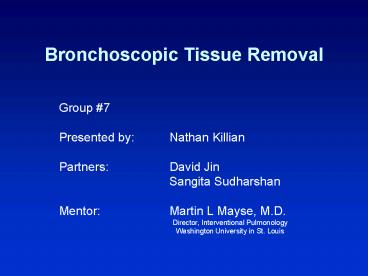Bronchoscopic Tissue Removal PowerPoint PPT Presentation
1 / 38
Title: Bronchoscopic Tissue Removal
1
Bronchoscopic Tissue Removal
- Group 7
- Presented by Nathan Killian
- Partners David Jin
- Sangita Sudharshan
- Mentor Martin L Mayse, M.D.
- Director, Interventional Pulmonology
- Washington University in St. Louis
2
Lung Obstructions
- Lung cancer is the primary cause
- 175,000 new cases
- 30 will develop symptomatic obstruction
- 98 would die on a ventilator without
bronchoscopic removal - Still many problems
- 3
16
3
Project Scope
- Design a new bronchoscopic tissue removal device
to solve the most critical problems existing with
current devices
4
In This Presentation
- Review most common bronchoscopic tissue removal
techniques - (results of literature searches)
- Discuss our design requirements based upon the
problems we found - Present specifications and preliminary
mathematical analysis for our device
5
Bronchoscopes
16
Flexible
Rigid
6
Bronchoscopic Technique
7
Types of Obstructions
3
Endoluminal Extraluminal Mixed
8
Mechanical Debulking
6
10
16
Rigid Core-out
Forceps Debridement
Suctioning
9
Mechanical Debulking
- Advantages
- Fine control over amount/location of tissue
removed - Quick relief of airway obstruction
- Can be used through both flexible and rigid
bronchoscopes - Tissue sample can be removed
1
10
Mechanical Debulking
- Disadvantages
- Poor hemostasis
- Poor limiting of local disease recurrence (short
durability) - Takes a long time through a flexible bronchoscope
1
11
Electrocautery
16
12
Argon Plasma Coagulation
13
Electrocautery
- Advantages
- Immediate relief of airway obstruction
- Can be used through both rigid and flexible
bronchoscopes - Excellent hemostasis
- Fine control over amount of tissue destruction
- Slows local disease recurrence
2
14
Electrocautery
- Disadvantages
- Delayed collateral tissue damage is possible
- Cannot be used for patients with pacemakers and
automated implantable cardiac defibrillators - Risk for endobronchial fires, hemorrhages, and
electrical shock to patients or operators - Tissue sample cannot be removed
2
15
Cryotherapy
16
16
Cryotherapy
- Advantages
- Can be used through both rigid and flexible
bronchoscopes - Excellent hemostasis
- Little risk of injury to neighboring healthy
tissue - Slows local disease recurrence
4
17
Cryotherapy
- Disadvantages
- Very slow effect and clearing of airway
obstruction - Tissue sample cannot be removed
4
18
LASER Resection
16
19
LASER Resection
- Advantages
- Fine control over amount of tissue destroyed
- Slows local disease recurrence
- Excellent hemostasis
- Quick airway obstruction relief
- Can be used through both flexible and rigid
bronchoscopes
5
20
LASER Resection
- Disadvantages
- Risk of endobronchial fires if used in an
oxygen-rich environment - Risk of airway perforation
- Tissue sample cannot be removed
5
21
Brachytherapy
16
22
Brachytherapy
- Advantages
- Can treat deep obstructions
- Potentially curative for inoperable, early stage
tumors - Excellent hemostasis
- Can be used through both flexible and rigid
bronchoscopes
3
23
Brachytherapy
- Disadvantages
- Very slow relief of airway obstructions
- Risk of deep tissue destruction
- Tissue sample cannot be removed
3
24
Photodynamic Therapy
Pre-Treatment
LASER Application
Post-Treatment
16
25
Photodynamic Therapy
- Advantages
- Can be used through both flexible and rigid
bronchoscopes - Selective destruction of tumor
- Limits local disease recurrence
- Excellent hemostasis
5
26
Photodynamic Therapy
- Disadvantages
- Patients receiving treatment must avoid direct
sunlight for up to 6 weeks following the
procedure - Tissue sample cannot be removed
5
27
Summary of Therapy Qualities
28
Design Requirements
- Be used in either rigid or flexible bronchoscope
- Minimize collateral damage
- Have an immediate effect
- Control bleeding
- Recover specimens
- Have a durable effect (gt 1 month)
- Cost less than 1,000 to make
29
Design Specifications
- Flexibility is primary consideration
- Diameter
- Less than 2.2 mm ideal for 5 mm scope
- 2.2 2.8 maximum for 6 mm scope
- Length
- At least 60 cm working length
- Materials
- Biocompatible (e.g. stainless steel, silicone
plastic, ABS plastic) 8,9,10 - Reusable (washed and autoclaved)
- Weight consistent with current tools
30
More Specs
- Suction must be less than 300 mmHg (max wall
suction used in hospitals) - For electrocautery, LASER resection, cryotherapy,
etc. - Device must be compatible with common OLYMPUS
devices used in hospitals
31
Preliminary Mathematical Analysis
- Heating of tissue with electrocautery
- Heating of tissue with LASER resection
- Suction pressure to displace tissue
32
Heating with Electrocautery
- Set your Argon plasma probe to 15 W
s
14
33
Heating with LASER Resection
- Total absorbed power density Capacity of
material to conduct heat away from impact site
Heat absorbed from laser at impact - K thermal conductivity
- tp duration of irradiation
- p density
- Cv specific heat per unit volume
- (T1-T0) change in temperature
- (1-R) absorption coefficient
- Io laser intensity
- 1460 W/cm2 needed to vaporize biological tissue
13
34
Suction Needed to Displace Tissue
- Assume we have a 4 mm long piece of tissue that
we want to stretch 2 mm
15
35
Project Schedule
36
Work Distribution
- Nathan
- Preliminary presentation
- Design focus electronics, energy sources
- Literature and patent searches
- Sangita
- Progress presentation
- Design focus materials
- Safety management
- David
- Final presentation
- Design focus mechanics
- Website development
37
References
- Prakash, U., Advances in Bronchoscopic
Techniques., American College of Chest
Physicians, 1999(116) 1403-1408. - Ernst, A., et. al., Interventional Pulmonary
Procedures., American College of Chest
Physicians., 2003(123) 1693-1717 - Leh, S., Mayse, M., Role of Interventional
Pulmonology., Washington University in St. Louis. - Mathur, PN, et. al., Fiberoptic bronchoscopic
cryotherapy in the management of tracheobronchial
obstruction, Chest, 1996(110) 718-723. - Simoff, Michael J., Endobronchial Management of
Lung Cancer, Cancer Control, 2001(84)337-343. - http//www.tobacco-facts.info/bronchoscopy.htm
- http//caonline.amcancersoc.org/cgi/reprint/55/1/1
0.pdf - http//en.wikipedia.org/wiki/Silicone
- http//www.sdplastics.com/abs.html
- http//www.escomedical.com/
- http//www.chestjournal.org/cgi/content/full/116/5
/1403 - http//www.medscape.com/viewarticle/455720_10
- http//www.chestjournal.org/cgi/content/full/120/3
/934 - http//www.engineeringtoolbox.com/specific-heat-ca
pacity-food-d_295.html - http//www.medscape.com/viewarticle/489484_print
- Images borrowed from Dr. Mayse
38
Questions?

